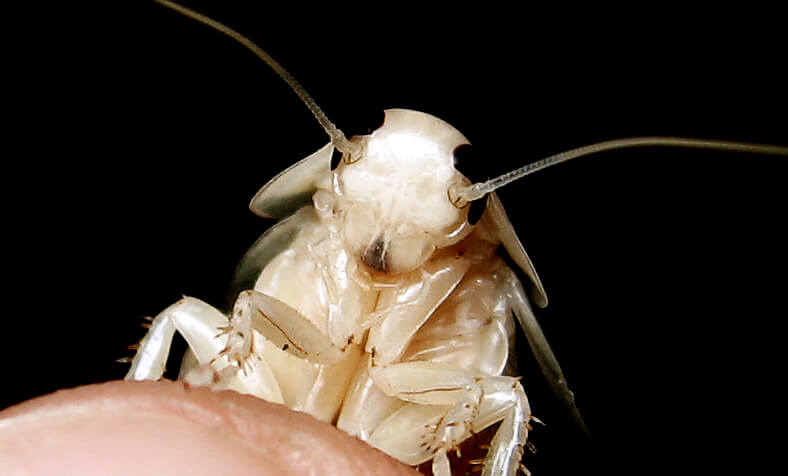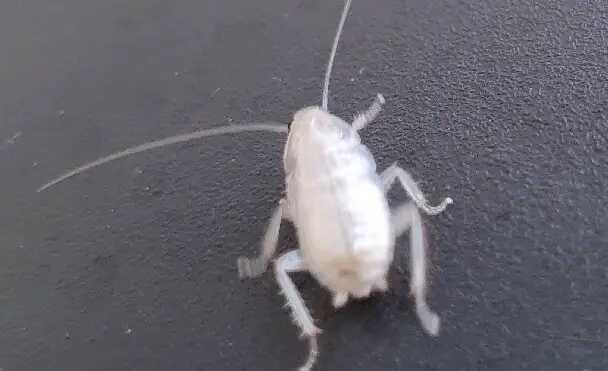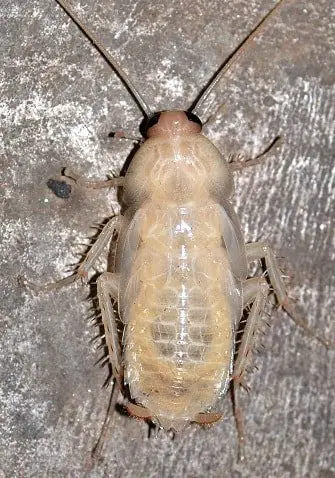What Are White Roaches?

In the insect world, arthropods such as insects and crustaceans follow a unique growth pattern that intrigues biologists and homeowners alike. Among these fascinating processes is molting, which gives rise to the occasional sighting of a white cockroach.
What is this elusive creature? Is it an albino variant? Or is it signaling a larger infestation problem? Let’s delve into these questions and unravel the mystery of the white cockroach.
Understanding Molting in Cockroaches
Cockroaches, just like all arthropods, don’t possess bones. Their skeletal system, known as an exoskeleton, is on the outside and provides the necessary rigidity for movement. This exoskeleton, composed of a chitin molecule, starts off as a soft white substance. The chitin dries out, hardens, and gradually changes color as it is exposed to air.
As a cockroach grows, it fills up the available space within its exoskeleton. There comes a point where it can no longer expand within the confines of this rigid structure. The solution? Molting.
The insect bursts out of its old exoskeleton and emerges with a new, soft, and notably white one. The coloration will shift over the next few hours from this pristine white to the cockroach’s typical color, depending on its species.
The cycle of molting is not a one-time occurrence. Cockroaches undergo multiple molts as they progress from nymphs to fully-grown adults.

Debunking the Albino Myth
Seeing a white cockroach often leads to being mislabelled as “albino.” This is a misconception. True albinism is a genetic condition where an organism cannot produce enough melanin pigment. No recorded evidence exists of a cockroach displaying this genetic trait.
Instead, the white appearance of a cockroach is a temporary phase after molting, as its new exoskeleton is still undergoing the hardening and pigmentation process.
Spotting a White Cockroach
If you ever stumble upon a white cockroach in your home, it’s more significant than just observing a biological phenomenon. Cockroaches are discreet creatures.
They prefer to molt in the shadows, away from potential threats. Being soft and vulnerable after molting, they are at a higher risk from predators. Thus, seeing a white cockroach implies it felt safe and undisturbed in that location.
More importantly, the sighting of one often indicates there could be many more lurking nearby. Cockroaches are gregarious and tend to congregate in harborage areas.
Finding a molting cockroach can be a sign of an infestation. Such an infestation may require immediate attention and possibly professional extermination services.
Diverse Colors
It’s essential to recognize that while all cockroach species may appear white post-molting, their final colors vary. From light brown to almost pure black, the diversity in cockroach species results in a spectrum of shades. The duration of the transition from white to their regular color also varies, with some species taking longer than others.
White Cockroach Infestation
Upon discovering a white cockroach, immediate action is advisable. Firstly, inspect the vicinity of the sighting, checking for cracks, gaps, and warm, humid spaces. Cockroaches often dwell close to their food sources, so kitchens and dining areas are potential hotspots.
Consider expanding your search or hiring professionals if your inspection doesn’t yield results. Exterminators have specialized tools like inspection cameras to reach hard-to-access areas and effectively deal with infestations.

Are baby cockroaches white?
Yes, upon emerging from the egg case, baby cockroaches, known as nymphs, are initially bright white in color. They will harden and darken within hours.
Does white vinegar kill cockroaches?
No, white vinegar doesn’t kill cockroaches. It’s more of a cleaning agent and won’t eliminate a roach infestation.
Is White Cockroach Poisonous?
No, white cockroaches are not poisonous. However, like other roaches, they can carry diseases and contaminate food. They can also trigger asthma and allergies through their shed exoskeletons, feces, and egg cases.
Do White Roaches Bite?
Roach bites are rare, regardless of their color. A bite from a white roach is usually accidental and might occur if they feel threatened or if there’s food residue on your body.
Conclusion
While the sight of a white cockroach can be surprising, it’s merely a glimpse into the intricate lifecycle of these resilient insects. The molting process, albeit fascinating, can be an alarming sign for homeowners, pointing towards a more extensive lurking infestation.
As with most pest issues, early detection and action are critical to managing and eradicating the problem. So, next time you spot a white cockroach, you’ll know exactly what it signifies and how to respond.

James E. Butkovich, Pest control maven with a knack for eco-friendly & Chemical solutions. Blogger with a mission to make homes pest-free, one post at a time.